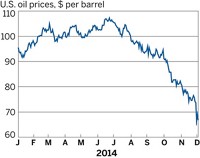Advertisement
Grab your lab coat. Let's get started
Welcome!
Welcome!
Create an account below to get 6 C&EN articles per month, receive newsletters and more - all free.
It seems this is your first time logging in online. Please enter the following information to continue.
As an ACS member you automatically get access to this site. All we need is few more details to create your reading experience.
Not you? Sign in with a different account.
Not you? Sign in with a different account.
ERROR 1
ERROR 1
ERROR 2
ERROR 2
ERROR 2
ERROR 2
ERROR 2
Password and Confirm password must match.
If you have an ACS member number, please enter it here so we can link this account to your membership. (optional)
ERROR 2
ACS values your privacy. By submitting your information, you are gaining access to C&EN and subscribing to our weekly newsletter. We use the information you provide to make your reading experience better, and we will never sell your data to third party members.
Environment
The New King Of Fossil Fuel
U.S. now leads the world in petroleum, natural gas production
by Jeff Johnson
October 21, 2013
| A version of this story appeared in
Volume 91, Issue 42
The U.S. has long been the world leader in using petroleum and natural gas resources. But now, the nation is on track to become, by year’s end, the world’s largest producer of these key fossil fuels. That is the conclusion of a recent analysis by the Energy Information Administration (EIA), an independent agency within the Department of Energy.
For the past few years, the U.S., Russia, and Saudi Arabia have been in a three-way global race for oil and natural gas production leadership, notes Jonathan Cogan, an EIA spokesman. In the new report, released on Oct. 4, EIA says the U.S. has now overtaken the field.
The growth, triggered by new shale oil and gas resources made accessible by advances in unconventional drilling methods, has been much discussed and well-known, but the speed is a surprise. Only a year ago, U.S. and international energy agencies, such as EIA and the International Energy Agency, predicted the U.S. would lead the world in petroleum and natural gas production, but those estimates put off the leadership change until the end of the decade (C&EN, Dec. 3, 2012, page 30).
The report, Cogan notes, attempts to put the growth into a “big picture” context by combining the production of these two extremely valuable fossil fuels, but the analysis carries some problems.
To compare total output of petroleum and natural gas, EIA converted both into British thermal units, an energy value, but the energy content of crude oil, condensates, and natural gas produced in different parts of the world varies. Although he calls the conversions “rough,” Cogan says they are valuable for showing the overall trends.
EIA says the combined petroleum and natural gas hydrocarbon production for the U.S. and Russia for 2011 and 2012 were roughly equivalent—within 1 quadrillion Btu of one another. In 2013, however, the production figures widen, with the U.S. expected to outproduce Russia by 6 quadrillion Btu by the end of the year.
Because of shale oil technology in the U.S., for example, EIA figures show that oil production in North Dakota tripled between 2010 and 2013 and doubled in Texas over the same period. Texas crude oil output has been huge: This year, Texas will produce nearly half of the total crude oil coming from all 48 contiguous states, according to EIA.
Despite the growth, the U.S. still imports petroleum and gas to meet domestic demand, but much less so than in the past. In 2005, U.S. imports of petroleum products hit their peak over the past decade at 60% of consumption; today this value is 35%.
For natural gas, EIA notes that production since 2008 has increased by 4 quadrillion Btu, in large part because of unconventional drilling in the eastern U.S. Consequently, U.S. net natural gas imports are now about one-quarter of their 2005 amount—dropping from 20% of consumption to an average of 5% over the first six months of 2013.
But consumption by the world’s top three total oil and gas producers tells a different story.
For petroleum, unlike the U.S., which consumes more than it produces, Russia and Saudi Arabia consume only around 30% of their production. For gas, Russia uses about 75% of its domestic production and Saudi Arabia consumes nearly all of its much lower level of production.
Looking toward the future, the world shouldn’t forget China, the fastest-growing international petroleum consumer. It uses slightly more than half of the petroleum the U.S. does but produces about 40% of what it consumes. China’s petroleum consumption has grown by one-third since 2008, according to EIA figures. For natural gas, China consumes about one-fifth the U.S. level and imports about one-third of what it consumes.





Join the conversation
Contact the reporter
Submit a Letter to the Editor for publication
Engage with us on Twitter